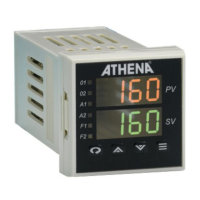Two communication
options are available
for the Series 16
which allow interfac-
ing to remote devices
utilizing the most
common industry
standards, RS232
and RS485.
WARNING
Signal ground only.
Grounding to frame
may damage the
controller and void
warranty.
Digital
Communications
RS232
This method allows bidirectional data transfer via a three-conductor cable consisting of signal ground,
receive input and transmit output. It is recommended for communication distances less than fifty feet
between the computer terminal and the instrument. Note: Multiple instruments cannot be connected to the
same port.
The RS232 port is optically isolated to eliminate ground loop problems. Typically, “Data Out” of the
computer/terminal connects to the “RCV” terminal. “Data In” connects to the “XMT” terminal. If shielded
cable is used, it should be connected to the frame ground at one end only. Signal ground is to be connected
at appropriate ground terminals (refer to wiring diagram, page 28).
RS485
The RS485 multipoint capability allows up to 32 controllers to be connected together in a half-duplex
network or up to 100 controllers with an appropriate communications repeater. This method allows
bidirectional data transfer over a shielded twisted pair cable. The twisted pair cable is a transmission line;
therefore, terminating resistors are required at the most distant ends of the line to minimize reflections
(typically 60 ohms from each line to signal ground). The RS485 circuit is fully optically isolated, eliminating
ground loop problems. Parallel drops from the transmission lines should be kept as short as possible;
however, the line may be daisy-chained at each controller. The polarity of the line is important and each
device will specify an “A” (+) and “B” (-) connection.
Figure 17. Wiring diagram for digital communications.
Note: Call factory for
a recommended
RS485 converter.

